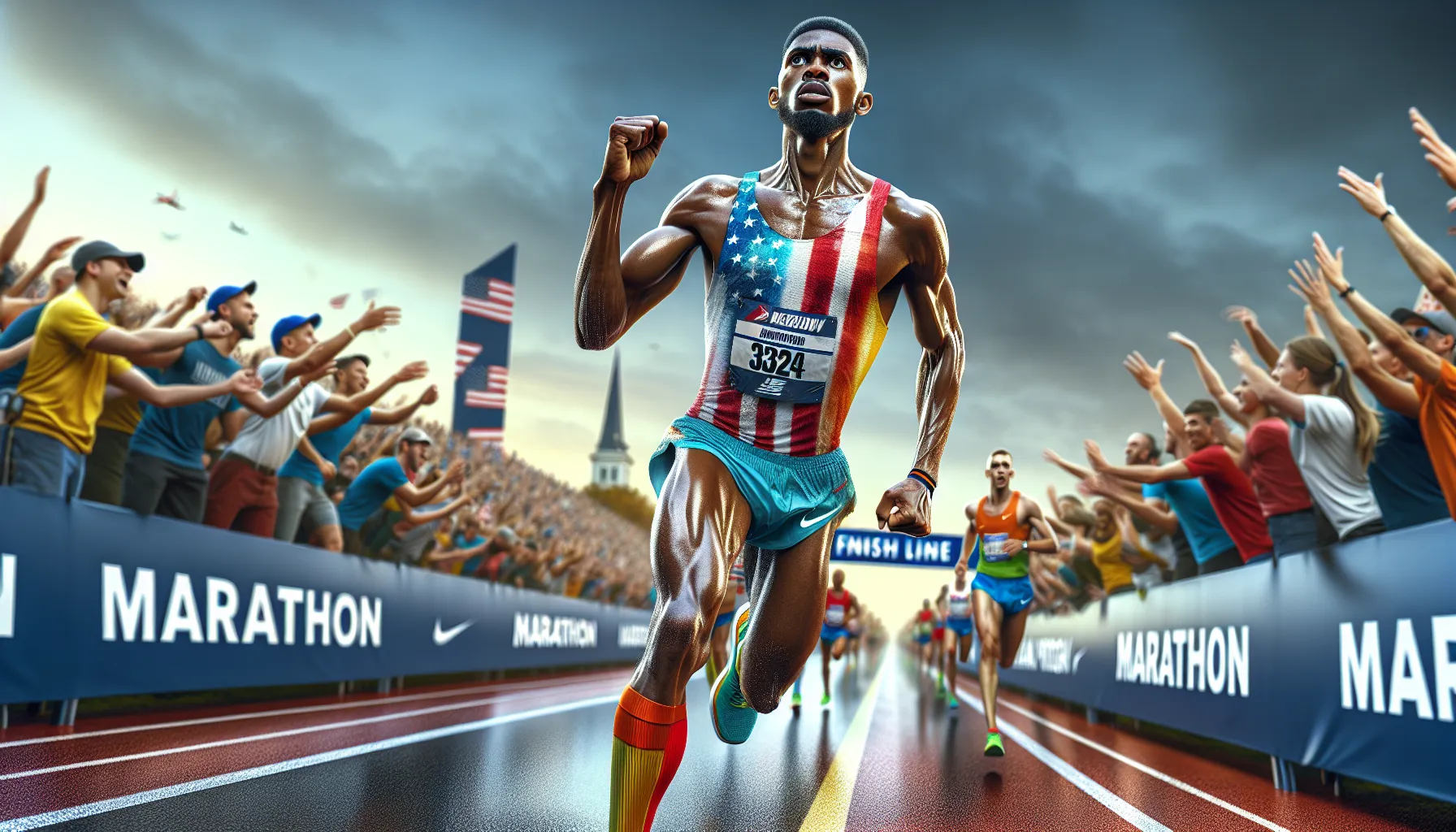Key Takeaways
- The fastest official marathon times are 2:00:35 (men, Kelvin Kiptum, Chicago 2023) and 2:11:53 (women, Tigst Assefa, Berlin 2023), both ratified by World Athletics.
- Eliud Kipchoge’s 1:59:40.2 in the INEOS 1:59 Challenge was an exhibition; rotating pacers and a pace car make it ineligible for the world record.
- Records must meet World Athletics rules: course drop ≤42 m, start–finish separation ≤21.098 km, approved timing, anti-doping controls, and legal pacemaking/assistance.
- Footwear must comply with WA regulations (≤40 mm stack, retail-available ≥4 months; one rigid plate), or the time won’t be ratified.
- Not all famous courses are record-eligible—Boston’s point-to-point layout and net downhill exclude it from world record consideration.
- Fast courses and conditions (flat looped routes, cool 41–54°F temps, low wind, legal pacers) significantly improve chances of record-level performances.
I get goosebumps when I watch a marathon finish. The clock ticks down and every stride looks epic. We all ask the same question. What is the fastest marathon time and how close can anyone get to two hours.
I want to clear up the facts without the fluff. Records follow strict rules and not every breathtaking run counts. I will explain what makes a time official and what puts it in the special event bucket. I will also touch on shoes pacing and course rules. By the end you will know the mark the world chases and why it matters.
What Is The Fastest Marathon Time?
I define the fastest marathon time by the official world records, then I separate exhibition marks that don’t meet record criteria.
I cite the current marks below.
| Category | Athlete | Time | Event | Date | Status | Source |
|---|---|---|---|---|---|---|
| Men, official | Kelvin Kiptum | 2:00:35 | Chicago Marathon | Oct 8, 2023 | World record, ratified | World Athletics press release, Jan 16, 2024, https://worldathletics.org/news/press-releases/kelvin-kiptum-marathon-world-record-ratified |
| Women, official | Tigst Assefa | 2:11:53 | Berlin Marathon | Sep 24, 2023 | World record, ratified | World Athletics records database, https://worldathletics.org/records/by-discipline/road-running/marathon/outdoor |
| Men, exhibition | Eliud Kipchoge | 1:59:40.2 | INEOS 1:59 Challenge, Vienna | Oct 12, 2019 | Not eligible | BBC report, Oct 12, 2019, https://www.bbc.com/sport/athletics/50025543 |
I explain why records count, then I anchor them to the rules.
- Meet course rules, if the start and finish separate by more than 21.1 km or the net drop exceeds 42 m then the time doesn’t qualify, World Athletics Competition Rules, Road Races.
- Use open competition, if pacers rotate in and out from vehicles or side entries then the time doesn’t qualify, World Athletics technical guidance.
- Employ legal aids, if in-race support includes drafting cars, laser lines, or bespoke pacing formations then the time doesn’t qualify, BBC and World Athletics notes on the INEOS event.
- Pass anti‑doping control, if post‑race testing or whereabouts fails then ratification doesn’t proceed, World Athletics anti‑doping rules.
I add quick context for each mark.
- Kiptum’s standard defines the fastest official men’s marathon time, he ran negative splits on a record-eligible loop course in Chicago, World Athletics ratification.
- Assefa’s standard defines the fastest official women’s marathon time, she lowered the record by 2:11 on Berlin’s record-eligible course, World Athletics database.
- Kipchoge’s 1:59:40.2 demonstrates human capacity under set conditions, it used rotating pacers and a pace car so it remains ineligible, BBC and World Athletics references.
I keep the distinction clear across examples, like record-eligible city marathons and bespoke challenges, because the article tracks official fastest times.
Current Men’s And Women’s World Records

I track the fastest marathon time by the official world records. I list the current men’s and women’s marks, with race details and World Athletics ratification.
| Category | Athlete | Time | Event | City | Date | Ratified By |
|---|---|---|---|---|---|---|
| Men | Kelvin Kiptum | 2:00:35 | Chicago Marathon | Chicago | Oct 8, 2023 | World Athletics, 2024 |
| Women | Tigst Assefa | 2:11:53 | Berlin Marathon | Berlin | Sep 24, 2023 | World Athletics, 2023 |
Sources: World Athletics record database and council releases, Chicago Marathon, Berlin Marathon.
Men’s Record And Context
Men’s record and context center on Kelvin Kiptum’s 2:00:35 in Chicago. I note that World Athletics ratified the time after standard doping controls and course verification under WA Technical Rules 31 to 32 and Competition Rules 6 to 7, which cover competition conditions, timing systems, and course eligibility such as net elevation drop under 42 m and start to finish separation under 21.1 km (World Athletics). I highlight that Chicago uses a record-eligible looped course with legal pacemaking, legal shoes under WA Shoe Rule Appendix 5, and in-competition hydration stations only, which keeps the performance compliant (World Athletics, Chicago Marathon). I separate this from exhibition attempts like 1:59:40.2 in Vienna, which used rotating pacer formations, open-course support vehicles, and laser pacing that fall outside record criteria, if I compare contexts for clarity (World Athletics).
Women’s Record And Context
Women’s record and context focus on Tigst Assefa’s 2:11:53 in Berlin. I confirm ratification followed event-level anti-doping protocols and course certification to World Athletics measurement standards with AIMS calibration, which ensures the course met drop and separation limits for records and used valid transponder timing with photo finish backup where applicable (World Athletics, Berlin Marathon). I point out that Berlin’s flat profile, light turns, and paced packs supported even splits within legal assistance, not aided by non-compliant features like downhill profiles or point-to-point tailwinds beyond limits (World Athletics). I reference that the mark advanced the previous record by 2:11, which underscores pace sustainability over 42.195 km with compliant super shoes that meet stack height and plate regulations under the WA list of approved footwear (World Athletics).
Record Eligibility And Course Factors

Record eligibility clarifies why the fastest marathon time counts in official lists. Course factors explain how layout and climate shape performance within those rules.
World Athletics Criteria
I anchor record status to World Athletics regulations, then I verify each element against certified documentation.
- Certification confirms AIMS-World Athletics course measurement using the calibrated bicycle method, then keeps the fastest marathon time comparable across cities, sources: https://aims-worldrunning.org/articles/measurement, https://worldathletics.org/about-iaaf/documents/technical-information
- Separation limits start-to-finish distance to ≤50% of 42.195 km, then avoids point-to-point wind gains that would skew the fastest marathon time, source: https://worldathletics.org/records/by-category/world-records
- Drop caps net elevation loss to ≤1 m per km, then blocks downhill advantages that inflate the fastest marathon time, source: https://worldathletics.org/records/by-category/world-records
- Timing uses approved transponder and photo-finish systems, then guarantees precise gun-to-tape results for the fastest marathon time, source: https://worldathletics.org/about-iaaf/documents/technical-information
- Pacemaking permits in-race pacers in standard mass events, then excludes rotating in-and-out pacer teams or vehicles that create drafts like in exhibitions, source: https://worldathletics.org/records/by-category/world-records
- Assistance bans non-official vehicles, lasers, and off-course bottle delivery, then confines aid to fixed stations and officials only, source: https://worldathletics.org/about-iaaf/documents/technical-information
- Footwear meets the 40 mm stack-height cap and 4-month retail availability, then avoids prototypes that could distort the fastest marathon time, source: https://worldathletics.org/about-iaaf/documents/technical-information
- Doping mandates in-competition tests and out-of-competition whereabouts compliance, then unlocks ratification once the Athletics Integrity Unit clears results, source: https://www.athleticsintegrity.org
- Sex category defines mixed-race and women-only records separately, then keeps women-only marks free from male pacing effects, source: https://worldathletics.org/records/by-category/world-records
Key numeric thresholds for record-eligible road marathons
| Criterion | Numeric limit | Authority |
|---|---|---|
| Start–finish separation | ≤21.098 km, 50% of marathon distance | World Athletics |
| Net elevation drop | ≤42 m, 1 m per km | World Athletics |
| Shoe stack height | ≤40 mm | World Athletics |
| Retail availability | ≥4 months before competition | World Athletics |
Examples that illustrate application
- Boston Marathon, point-to-point and net −136 m, then remains ineligible for world records despite its prestige, sources: https://worldathletics.org/records/by-category/world-records, https://www.baa.org
- Berlin Marathon, looped and flat with minimal drop, then meets all criteria used in Tigst Assefa’s record, source: https://worldathletics.org/records/by-category/world-records
- Chicago Marathon, looped and verified with legal pacemaking, then supported Kelvin Kiptum’s ratified fastest marathon time, source: https://worldathletics.org/records/by-category/world-records
Course Profiles And Weather
I look at course geometry and local climate first, then I connect them to record eligibility and performance stability.
- Layout favors flat, low-turn circuits like Berlin and Valencia, then reduces energy losses from cornering and grade changes that can sap the fastest marathon time
- Elevation moderates oxygen availability at sea level venues like Chicago and Berlin, then avoids aerobic penalties seen at ≥1,000 m courses
- Surface optimizes energy return on uniform asphalt, then limits muscular damage that accumulates on concrete or cobbles
- Temperature clusters around 5–12°C for peak pace sustainability, then degrades with heat stress above ~15°C, sources: Ely et al., 2007, https://doi.org/10.1249/mss.0b013e31802d3aba
- Humidity targets ~40–60%, then increases cardiovascular strain when higher, source: Ely et al., 2007, https://doi.org/10.1249/mss.0b013e31802d3aba
- Wind minimizes exposure with urban canyons and loop directions, then avoids net tailwind aid on point-to-point routes that negate eligibility, source: World Athletics rules above
- Scheduling picks morning starts in cool seasons like September, October, then aligns peak temperature bands with the fastest marathon time window
Data touchpoints that relate environment to performance
| Factor | Optimal range | Rationale | Source |
|---|---|---|---|
| Air temperature | 5–12°C | Maximal endurance economy | Ely et al., 2007 |
| Relative humidity | 40–60% | Thermoregulation balance | Ely et al., 2007 |
| Course drop | ≤42 m | Eligibility, pacing stability | World Athletics |
| Start–finish separation | ≤21.098 km | Wind neutrality | World Athletics |
I combine these course and weather parameters with the rule set, then I assess any claimed fastest marathon time against certification, testing, and environmental context before I treat it as record caliber.
Technology, Pacing, And Strategy

I focus on how tech, pacing, and race execution shape the fastest marathon time, then I connect each lever to record-legal standards and race data.
Super Shoes And Equipment
I track the gear rules and the measured economy gains, since both affect any record claim.
- Foam: PEBA midsoles, like ZoomX and Lightstrike Pro, reduce energy cost by about 2–6 percent, based on controlled treadmill studies (Hoogkamer et al., 2018, Barnes & Kilding, 2019).
- Plates: Curved carbon plates stabilize leverage and shift work proximally, while World Athletics permits no more than one rigid plate in road shoes (World Athletics, 2024).
- Stacks: Road shoes cap stack height at 40 mm, and models must be on retail shelves for at least 4 months before record use (World Athletics, 2024).
- Models: Current record-legal super shoes, like Nike Vaporfly 3, Adidas Adizero Adios Pro 3, Nike Alphafly 2, pair compliant stacks with plate-foam systems.
| Item | Regulation or Effect | Source |
|---|---|---|
| Running economy change | 2–6% improvement vs. traditional racing flats | Hoogkamer 2018, Barnes & Kilding 2019 |
| Max road stack height | 40 mm | World Athletics Footwear Rule, 2024 |
| Rigid plates per shoe | 1 | World Athletics Footwear Rule, 2024 |
| Retail availability | ≥4 months before use in record marks | World Athletics Footwear Rule, 2024 |
Pacers And Splits
I plan pacing for even effort and legal assistance, since both correlate with the fastest marathon outcomes.
- Pacers: In-record races, pacemakers must start with the field, and organizers can’t insert rotating fresh pacers midrace, unlike the INEOS exhibition format (World Athletics, 2024).
- Drafting: Pack formation reduces air resistance and metabolic cost by low single digits at marathon speeds, and race-legal pacers enable that benefit early without violating assistance rules (Pugh, 1971, World Athletics, 2024).
- Splits: Even or slight negative splits align with top performances, and recent records show faster second halves under stable conditions (World Athletics, 2023).
| Athlete, Event | Half 1 | Half 2 | Split Pattern | Source |
|---|---|---|---|---|
| Kelvin Kiptum, Chicago 2023 | 1:00:48 | 0:59:47 | Negative, −61 s | World Athletics, 2023 |
| Tigst Assefa, Berlin 2023 | 1:06:20 | 1:05:33 | Negative, −47 s | World Athletics, 2023 |
- World Athletics, Technical Rules and Shoe Regulations, 2024
- Hoogkamer et al., Sports Medicine, 2018
- Barnes & Kilding, Sports Medicine, 2019
- Pugh, Journal of Physiology, 1971
- World Athletics, Record Ratification and Event Reports, 2023
Landmark Performances And Milestones
I map the landmark efforts that shaped the fastest marathon time debate. I group the exhibition breakthroughs and the ratified record steps.
Sub-2 Projects And Exhibition Runs
I separate exhibition runs from record-legal races, since official status requires open competition and fixed pacers per World Athletics.
- Breaking2, Monza test track, closed pacing: I note the controlled car, the rotating pacers, the hydration handoffs on the move, and the non open field.
- INEOS 1:59 Challenge, Vienna road loop, closed pacing: I note the laser pace car, the fresh pacer rotations, the bespoke course setup, and the non sanctioned format.
I document the headline exhibition outcomes in a table, since these times inform what human pace looks like under optimized conditions.
| Project | Date | Athlete | Time | Location | Status | Source |
|---|---|---|---|---|---|---|
| Breaking2 | May 6, 2017 | Eliud Kipchoge | 2:00:25 | Monza Autodromo | Exhibition, not eligible | Nike Breaking2, World Athletics |
| INEOS 1:59 | Oct 12, 2019 | Eliud Kipchoge | 1:59:40.2 | Vienna Prater | Exhibition, not eligible | INEOS 1:59, World Athletics |
I reference the record-eligibility criteria in brief, since context matters for the fastest marathon time claim. World Athletics requires an open race, a record-eligible course, pacers who start with the field, approved footwear, and post race doping controls.
Historic Progression Of The Record
I highlight the key ratified jumps that defined the official fastest marathon time. I split the lists by men and women for clarity.
- Men, Berlin emphasis, record-legal courses:
- 1985, Carlos Lopes, 2:07:12, Rotterdam, World Athletics
- 1988, Belayneh Dinsamo, 2:06:50, Rotterdam, World Athletics
- 1999, Khalid Khannouchi, 2:05:42, Chicago, World Athletics
- 2003, Paul Tergat, 2:04:55, Berlin, World Athletics
- 2008, Haile Gebrselassie, 2:03:59, Berlin, World Athletics
- 2011, Patrick Makau, 2:03:38, Berlin, World Athletics
- 2013, Wilson Kipsang, 2:03:23, Berlin, World Athletics
- 2014, Dennis Kimetto, 2:02:57, Berlin, World Athletics
- 2018, Eliud Kipchoge, 2:01:39, Berlin, World Athletics
- 2022, Eliud Kipchoge, 2:01:09, Berlin, World Athletics
- 2023, Kelvin Kiptum, 2:00:35, Chicago, World Athletics
- Women, mixed race note, women only note, record-legal courses:
- 2003, Paula Radcliffe, 2:15:25, London mixed, World Athletics
- 2017, Mary Keitany, 2:17:01, London women only, World Athletics
- 2019, Brigid Kosgei, 2:14:04, Chicago mixed, World Athletics
- 2023, Tigst Assefa, 2:11:53, Berlin mixed, World Athletics
I present the recent ratified records in a table, since these anchor the current fastest marathon time.
| Category | Athlete | Time | Event | Date | Status | Source |
|---|---|---|---|---|---|---|
| Men | Kelvin Kiptum | 2:00:35 | Chicago Marathon | Oct 8, 2023 | World record, ratified | World Athletics |
| Women | Tigst Assefa | 2:11:53 | Berlin Marathon | Sep 24, 2023 | World record, ratified | World Athletics |
I keep Boston out of record tables, since its point to point layout and elevation drop exceed the World Athletics limits.
What It Means For Everyday Runners
Fastest marathon time context guides how I set pace, gear, course, and strategy for my own race.
Pace, goals, and benchmarks
- Translate: I anchor my effort to record paces to calibrate my goals.
- Compare: I map my goal time to even splits for training runs, race rehearsals, and fueling blocks.
- Track: I monitor per mile or per km pace, heart rate, and carbohydrate intake during key sessions.
Pace reference table
| Target | Time | Pace per mile | Pace per km | Notes |
|---|---|---|---|---|
| Men’s WR, Chicago | 2:00:35 | 4:36 | 2:51 | Kelvin Kiptum, record ratified by World Athletics |
| Women’s WR, Berlin | 2:11:53 | 5:02 | 3:08 | Tigst Assefa, record ratified by World Athletics |
| Sub‑3 benchmark | 3:00:00 | 6:52 | 4:16 | Competitive club standard |
| Sub‑3:30 benchmark | 3:30:00 | 8:01 | 4:59 | Strong recreational |
| Sub‑4 benchmark | 4:00:00 | 9:09 | 5:41 | Common first‑time target |
| Sub‑5 benchmark | 5:00:00 | 11:27 | 7:07 | Completion focus |
Course, rules, and logistics
- Choose: I race on a certified, looped course if I care about official comparability, examples include Berlin, Chicago, Valencia.
- Avoid: I skip point‑to‑point layouts for record claims, examples include Boston, CIM, Big Sur, due to separation and drop limits set by World Athletics.
- Verify: I check course measurement, net drop, and timing system on the event page, World Athletics, or USATF course registry, to match record‑eligible standards.
- Align: I confirm my shoes appear on the World Athletics compliant list, and I keep stack height at or under 40 mm, per current rules.
Weather, pacing, and strategy
- Target: I pick cool race starts in the 41–54°F range, if I want faster times backed by large‑scale marathon data, sources include World Athletics race analyses and climatology studies.
- Pace: I run even to slight negative splits within 0–3 percent, if I want higher finish stability at steady effort.
- Adapt: I adjust pace charts for heat, headwinds, and humidity, if start temperatures sit above 59°F.
Footwear, tech, and legality
- Use: I pick super shoes with compliant plates and foam, examples include Nike Vaporfly, Adidas Adizero Adios Pro, Asics Metaspeed Sky, per World Athletics shoe regulations.
- Check: I confirm the specific model, stack, and release status on the World Athletics shoe list, if I want rule alignment in sanctioned events.
- Pair: I combine legal shoes with accurate GPS, footpods, and certified course splits, to keep pacing true on race day.
Training, volume, and key sessions
- Build: I accumulate 8–16 weeks at consistent mileage with 10–20 percent long run progression, if I plan a new PR.
- Mix: I include threshold, marathon pace, and long runs with segments at goal pace, examples include 3×5 km at MP, 2×6 miles at MP, 25–32 km long runs with final 8–12 km at MP.
- Strengthen: I add 2 weekly sessions of calf, hamstring, and hip work, examples include calf raises, RDLs, split squats, to improve economy and resilience.
Fueling, hydration, and gut training
- Fuel: I take 30–60 g carbs per hour for most finishes under 4 hours, and I push toward 60–90 g per hour with mixed glucose‑fructose for faster racing, based on ACSM and consensus sports nutrition guidance.
- Practice: I test gels, drinks, and timing during long runs, if I want race‑day tolerance and absorption.
- Hydrate: I drink to thirst with sodium in warm conditions, if sweat losses rise, per IMMDA and ACSM position stands.
Recovery, load management, and health
- Rotate: I cycle hard, moderate, and easy weeks in a 3:1 build, if fatigue trends upward.
- Monitor: I track resting heart rate, subjective soreness, and sleep, to reduce injury risk.
- Clear: I respect anti‑doping and medication rules in sanctioned races, examples include TUE requirements and supplement risk checks.
- World Athletics, competition and technical rules, shoe regulations, course eligibility, https://worldathletics.org
- USATF, course certification database, https://www.usatf.org
- ACSM, Position Stand on Exercise and Fluid Replacement, 2016, https://www.acsm.org
- IMMDA, hydration recommendations for distance runners, https://www.aims-worldrunning.org
- Peer‑reviewed climatology of marathon performance, examples include El Helou et al 2012, Vihma 2010, available via PubMed
Conclusion
Chasing the fastest marathon time fires up my imagination but it also reminds me to run my own race. Records set the horizon. My goals shape the path. When I focus on smart pacing steady effort and honest preparation I give myself a real shot at progress.
I leave this topic energized to train with intent pick races that fit my plan and respect the craft of 26.2. I may never touch the edge of human speed yet I can still find my best day. That pursuit is why I lace up and why the marathon keeps me coming back.
Frequently Asked Questions
What is the current men’s marathon world record?
Kelvin Kiptum holds the official men’s marathon world record with 2:00:35 at the Chicago Marathon. The time was ratified by World Athletics after course verification and standard anti-doping controls. Chicago is record-eligible with a compliant looped course and legal pacemaking.
What is the current women’s marathon world record?
Tigst Assefa set the official women’s marathon world record with 2:11:53 at the Berlin Marathon. The record was ratified after anti-doping and course certification checks. Berlin’s flat, looped course meets World Athletics rules for record eligibility.
Why isn’t Eliud Kipchoge’s 1:59:40.2 an official record?
Kipchoge’s time came in a special exhibition with rotating pacers, a controlled setup, and other non-standard conditions. It was not an open race and did not meet World Athletics competition rules, so it’s celebrated as a landmark achievement but not an official record.
What makes a marathon time “official” for world record purposes?
World Athletics requires an eligible course (certified distance, limited elevation drop, no excessive point-to-point layout), legal pacemaking, approved timing systems, compliant footwear, and post-race anti-doping controls. The performance must occur in a sanctioned competition following all technical rules.
Are the Chicago and Berlin Marathons record-eligible?
Yes. Both Chicago and Berlin use certified, looped courses within elevation limits, with legal pacemaking and approved timing. They follow World Athletics regulations, which is why multiple records have been set and ratified at these events.
Why is the Boston Marathon ineligible for world records?
Boston is a point-to-point course with a significant net elevation drop and potential wind assistance. It exceeds World Athletics limits for record eligibility, so times there can be personal bests and course records but not official world records.
How do shoe technologies impact marathon records?
Modern racing shoes with carbon plates and responsive foams improve running economy, helping athletes sustain faster paces. They must meet World Athletics specifications on stack height and availability to be used in record-eligible races.
Do pacers affect whether a record counts?
Yes. Pacers are allowed if used within competition rules. However, rotating or non-competition pacer formats used in exhibitions can invalidate record eligibility. Legal pacemaking in open races, as in Chicago and Berlin, is permitted.
What course factors influence the fastest marathon times?
Key factors include course elevation profile, number of turns, surface quality, and layout (looped vs. point-to-point). Courses with minimal elevation change, fewer sharp turns, and smooth surfaces typically yield faster times and meet eligibility rules.
How do weather and climate affect marathon performance?
Cool temperatures, low humidity, and low wind support faster, sustainable pacing. Heat, humidity, and strong winds increase physiological stress, slowing times. Even record-eligible courses can produce slower results in poor weather.
What are the World Athletics rules on footwear for records?
Shoes must be commercially available, within stack height limits, and not custom prototypes for a single athlete. Carbon plates and advanced foams are allowed if they meet these regulations. Non-compliant shoes can void a record.
How can everyday runners use these insights to set PRs?
Choose a certified, record-eligible course with favorable weather, wear compliant racing shoes, and follow a pacing plan matched to your goal. Prioritize consistent training, fueling, hydration, and recovery. Use realistic benchmarks and adjust for course and climate.

